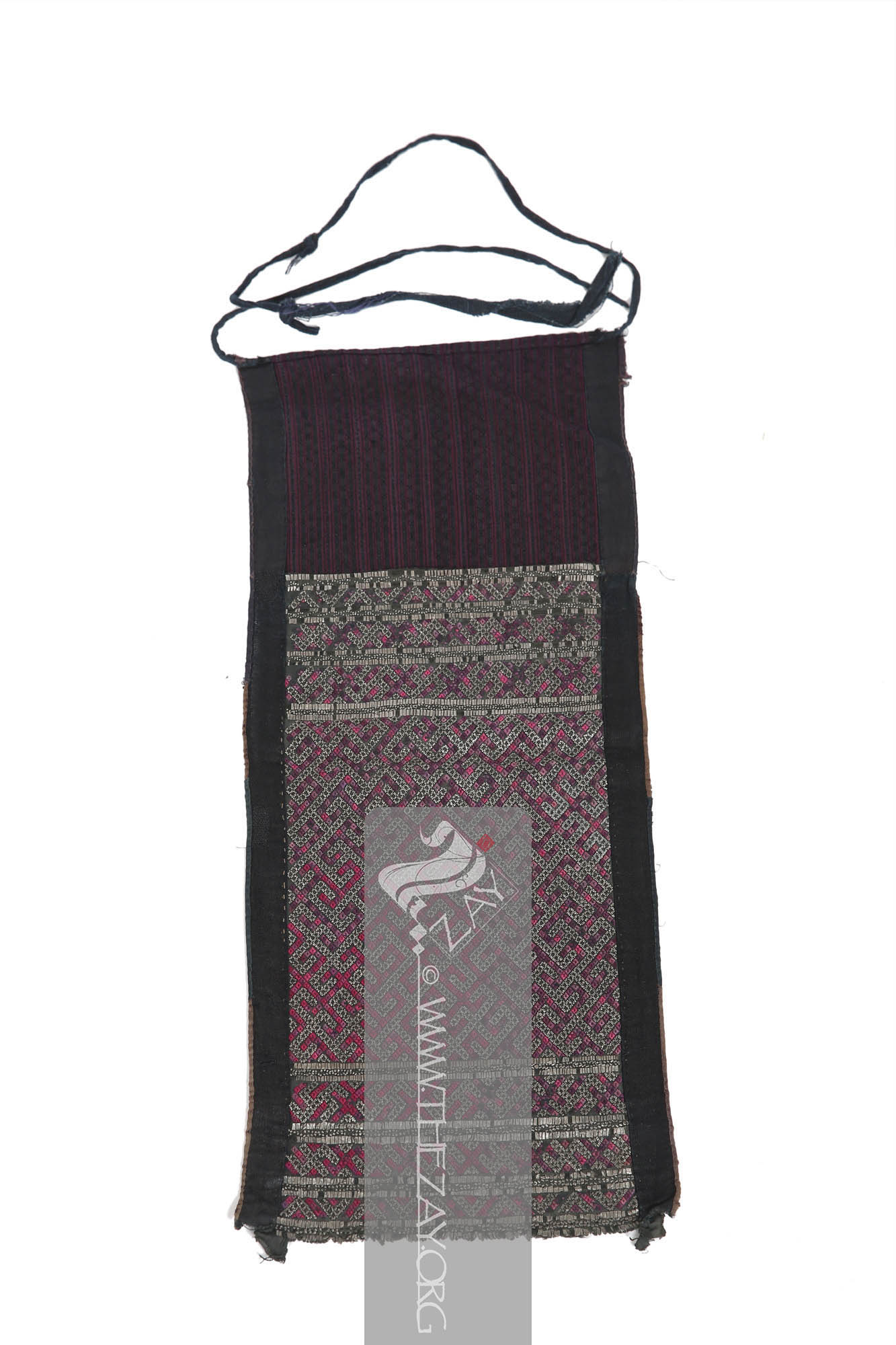Object NoteEnsemble set containing two more pieces including a jacket (
ZI2015.500242 ASIA) and a skirt (
ZI2015.500242a ASIA).
Object HistoryPart of an ensemble set, along with a skirt (ZI2015.500242a ASIA) and a jacket (
ZI2015.500242 ASIA) was acquired by Dr. Reem El Mutwalli in 2015 from Rare Earth Tribal Art Gallery/Museum, Chiang Mai, Thailand.
It is an original ethnic wear for women of the Black Miao tribe of Jianhe County in Guizhou, China from the c. 1950s. It was constructed completely by hand by a woman of the tribe in c.1958.
Object Features This is an ethnic Miao/Hmong women’s waistband or apron made of black colour silk fabric. Primarily woven in black starched silk, and pink, purple, and burgundy silk
floss
Floss: (Old French: flosche – nap of velvet), is a type of silk fibre obtained from the cocoons of wild silkworms. It is characterized by its long, fluffy fibers that are not tightly woven, making it ideal for use in various textile applications such as embroidery, lace-making, and sewing. threads and metal – tin/silver – foils this waistband embodies the cultural history of the Miao people – an ethnic group concentrated in the Guizhou province of south-west China.
It is quite easy to distinguish people of one Hmong tribe and their geographical location from the others simply by the wide variety of styles in their clothes. As such, this all-black ensemble clearly belongs to what is locally popular as the “Black Miao” tribe – called so because they predominantly wear black clothes – from Jianhe County, Guizhou.
Often used as a waistband this rectangular piece has a starched silk base dyed in (
indigo
Indigo: (Latin: Indigo – India, synonym: nil
Nīl: (Latin: indigo), Arabised term for Indigo, a natural dye belonging to the ‘Indigofera Tinctoria’ species of plants that have been cultivated in East Asia, Egypt, India, and Peru since antiquity. According to Pliny the Elder, it was named after India as it was the source of the dye.), a natural dye belonging to the ‘Indigofera Tinctoria’ species of plants that has been cultivated in East Asia, Egypt, India, and Peru since antiquity. According to Pliny the Elder, it was named after India as it was the source of the dye. ) and is woven in dark pink, burgundy, and purple silk
floss
Floss: (Old French: flosche – nap of velvet), is a type of silk fibre obtained from the cocoons of wild silkworms. It is characterized by its long, fluffy fibers that are not tightly woven, making it ideal for use in various textile applications such as embroidery, lace-making, and sewing.. The
floss
Floss: (Old French: flosche – nap of velvet), is a type of silk fibre obtained from the cocoons of wild silkworms. It is characterized by its long, fluffy fibers that are not tightly woven, making it ideal for use in various textile applications such as embroidery, lace-making, and sewing. weave creates a geometric meandering pattern resembling a Greek key – a geometric meandering pattern resembling a maze – design. The metal–tin/silver–foil embellishment superimposed on the weave also creates the same pattern but on a larger scale. Interestingly, this type of metal foil-embedded embroidery can be seen in abundance across the Middle East and is called (
talli
Tallī: (Turkish: tel – wire, string), Gulf Arab – a woven braided trimming made with metal wire, threads and ribbons often sewn on detachable panels used as embellishments. Other – (Synonym: tulle_bi_talli
Tūlle_bi_tallī: (French: Tulle – a city in France where fine material for veil was first made; Turkish: tel – wire; Synonym: tariq; talli; badla; khus_dozi ), series of small metal knots made on a woven net ground as embellishment. The term is commonly used in the North African Arab region specifically in Egypt.
; tariq; badla; khus_dozi), series of small metal knots made on a woven net ground as embellishment.
).
It has two thin linen strings attached to it that act as a fastener. It could be used as a waistband as well as a back ornament where the piece could be hung from or attached to the back of a jacket just like in (
ZI2015.500242 ASIA). Although it does not look like it serves any utilitarian purpose, the previous collector had termed it as an ‘apron’ in the description.
Links 







